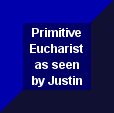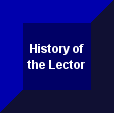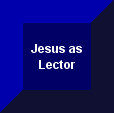
A Very Brief History of the Eucharist VicarDoug
The Celebration of the Eucharist was the New Passover Celebration.
The early Christians were Jews and knew the meaning of Passover.
The celebration of coming from slavery of to to freedom from sin.
The Mass Up 300 A.D.
In 150 A.D. St Justin Martyr explained how the Eucharist was celebrated to the emperor after he had been arrested. We have that writing today. You can use on of the links in the link column to look at it.
Assembly-The people are important and a part of the celebration. They gather and talk with each other, greet each other. They see themselves as the body of Christ. They see themselves as the Faithful. The faithful were need to celebrate Eucharist. The concept of the priest celebrating by himself was unknown at this time. The word priest was not used. He was called the presider or presbyter.
The Word-Old and new testament stories were proclaimed. The Word was proclaimed in the assembly in the language of the people
The Homily- The presbyter (priest) would break open the word with the homily to help all to apply what they had hear in the Word.
Prayers of the Faithful-They were the body of Christ praying to the Father. They were not for individual requests but for the Church, the world, the community, the sick, the dead.
Sign of Peace-Was after the homily. It was a time to reconcile before taking their gifts to the altar.
Eucharistic Prayer-There was no sacramentary. The presbyter make it up to the best of his ability.
400-800 A.D.
312 A.D. the emperor Constantine converts and Christianity was legal. Many pagans-non Jews enter the church with all their pagan ideas and practices. They no longer came with the understanding of the Passover, e.g. being a part of coming out of slavery-sin, and moving to freedom-eternal life.
Solemnity- becomes a part of the celebration. The pagans bring with them their fear of God. Their idea that this God like their pagan gods needs to be appeased.
Entrance Rite-replaces the gather and greeting each other that was in the celebration of Justin. Now the emperor enters the church and rite and song are used to greet him. The bishops and the priests too are greeted with music and rite.
Offeratory enters the liturgy. The pagans have the idea that they must placate God. They bring all kinds of produce and animals to offer to God. The priest receives these gifts along with the bread and wine. He now need to wash his hands and so the washing of the hands enters the liturgy.
Sacrifice-The pagans bring with them the idea they must sacrifice and appease God. The Eucharist is no long seen as and exultation of God because He has brought them from slavery to sin to the freedom of eternal life.
900-1400 A.D.
This, by many liturgists, is seen as the darkest period of liturgy. All the joy is gone from the mass. People no longer understand the concept of Passover. The language is in Latin which the common person does not understand. .
Need of Assembly Disappears-There is no longer a need for the assembly. They no longer participate. The priest has his back to the people during the celebration. The people no longer gather around the altar. There is a division. The sanctuary is for the clergy only. The communion rail appears to further divide the people
Private Prayers During Mass-The celebration of the mass becomes something the people don't understand and so they begin to pray their own private prayers, novenas, and rosaries during the mass. The readings are done but the people don't understand the language. The need for the homily disappears.
Silent Cannon The priests pray the prayers in silence or with only the altar boys answering the prayers. They people no longer participate other than just being present, saying their own individual prayers.
The Penitential Rite enters-People are not worthy. They must become worthy before the celebration of the mass. This becomes a focus.
Side Altars Appear-Since the mass is seen as a way to appease God, many masses are going on at the same time at the side altars. The more masses said the better. Priests even celebrate mass at an altar by themselves. Some priests only say many masses each day.
Communion Changes-Because the people are unworthy, they must receive once a year. They no longer receive in the hand as was the case in the celebration in the primitive Church. They begin to receive on the tongue as a sign of their unworthiness to touch Jesus. They no longer receive from the cup.
1500-1800 A.D.
This is the time of the Reformation. Luther does not understand Passover and all its traditions of celebrating coming from slavery-sin to freedom-eternal life. He gets rid of everything that is not in scripture.
The Council of Trent-The bread is no longer seen as needing to be like bread. The host becomes something that needs to be adored. The monstrance and benediction appear. People are no longer able to receive in the hand or from the cup. Only the worthy, the clergy can touch Jesus.
Devotion to the Blessed Sacrament Appears-During this time bells are rung at the most important times during the celebration so people will stop with their private prayers and look up and adore the Eucharist as it is elevated. My Lord and my God and they strike their breasts. Many spend great amounts of time in adoration before the Blessed Sacrament. The tabernacle become the central part of the church. The blessed sacrament is no longer reserved only for viaticum, but now needs to be reserved also for adoration.
Fixism-Now the celebration of the Eucharist, the mass is fixed. How the priests holds his hands, how many drops of water he places in the wine, etc. all become standard. There are no longer many Eucharistic prayers. Only one must be used for all occasions and at all times.
Renewal of the Liturgy
Begins in 1955
The Paschal Vigil is moved back to the night. It is no longer celebrated in the morning on Holy Saturday with just a few people.
Vatican II moved liturgy back to its roots in the primitive Church
Gathering rathn Entrance-The importance of the gathering of the people. The importance of people greeting each other as the Body of Christ as seen in the primitive Church.
Active Participation-The importance of the people participating in song and words. They are no longer passive people praying their own private prayers, rosaries, and novenas. They are the presence of Christ praying to their Father for all. They are a part of the one sacrifice of Christ that frees us from slavery-sin and leads us to freedom-eternal life. Here they are fed and nourished.
The Language of the people is used. All can understand. The use of bells is no longer needed but becomes optional.
The Responsorial Palm-The people are to actively participate
Side altars disappear. Only one mass may be going on at one time. A priests needs to have an assembly to celebrate mass unless there is some pastoral reason to do other wise.
Homilies Not Sermons-need to break open the scripture and apply it to the people. The homily is no longer optional.
Prayer of the Faithful-restored. The gather people are the body of Christ praying to the Father for the world.
The priest faces the people...The priest prays out loud and the people have a part. They are to participate.
The sign (Kiss of Peace) of Peace...is brought back from the ancient celebration of the mass.
Many Eucharistic Prayers...There are many options rather than just one. Many of the options are from very ancient times. The priest and community are no longer limited by just one. We are able to use many of the Eucharistic prayers of the ancient church and well as some recent ones approved by the bishops.
Laity Becomes Activity
Lay ministers appear
Eucharistic Ministers
Lay readers-Lectors
Signs Become Important Again
Bread looks more like bread. It is freshly made.
All liturgical sign are more appreciated.





